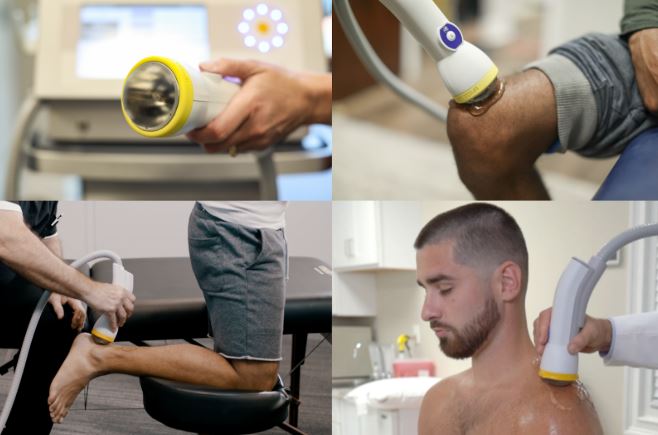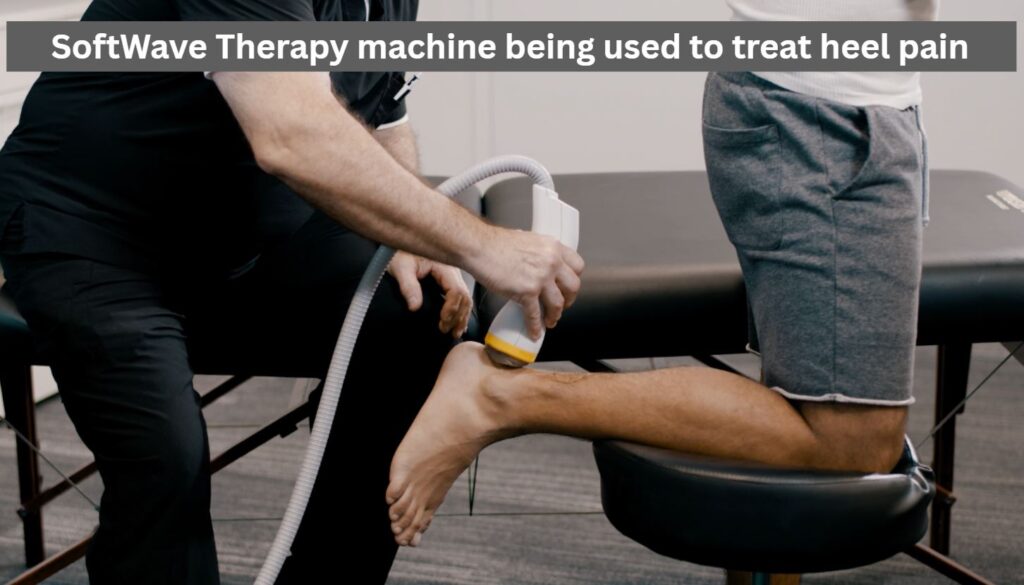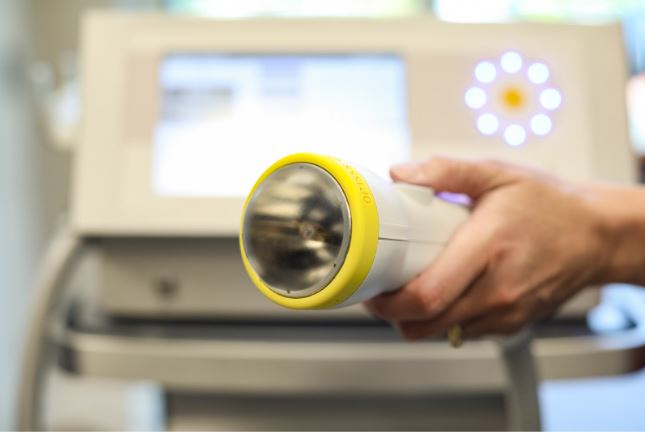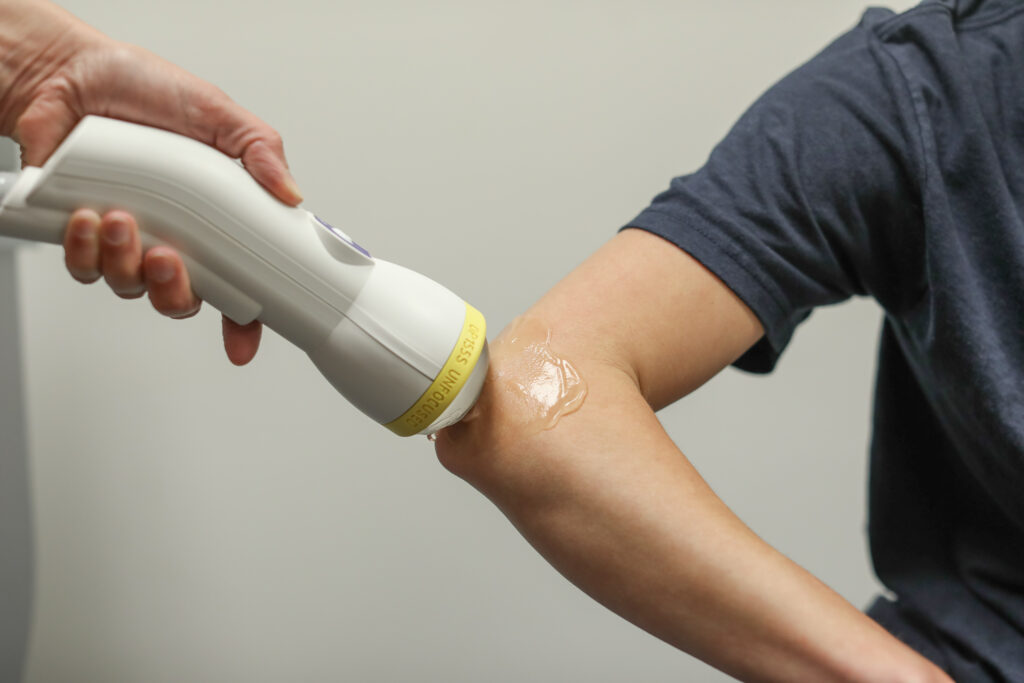SoftWave Therapy

We are excited to offer SoftWave therapy as another option to our patients who desire pain relief and functional improvement. SoftWave Therapy is rapidly becoming a trusted solution for patients seeking effective, non-invasive treatment for orthopedic conditions. Backed by advanced shockwave technology, SoftWave Therapy stimulates the body’s natural healing process, helping patients experience faster recovery times and lasting pain relief — all without surgery or prescription medications.
Whether you’re dealing with joint pain, chronic inflammation, or a stubborn soft tissue injury, SoftWave Therapy offers a modern approach to recovery. We proudly offer SoftWave Therapy as part of our commitment to delivering the latest, most effective treatments available today.
If you’re searching for a cutting-edge option to manage pain, improve mobility, and accelerate healing, SoftWave Therapy could be the ideal choice. Throughout this page, we’ll explain exactly what SoftWave Therapy is, how it works, who benefits most, and what you can expect from your first appointment.
What is SoftWave Therapy?
SoftWave Therapy is an advanced, non-invasive treatment that uses electrohydraulic shock waves to stimulate the body’s natural healing abilities. Also known as Extracorporeal Shockwave Therapy (ESWT), SoftWave Therapy uses sound waves to kickstart your body’s natural recovery process. It is a non-invasive treatment that stimulates healing in damaged tissues. It’s used in physical therapy, sports medicine, and orthopedics. ESWT emerged as a treatment for kidney stones and has evolved as an effective treatment for musculoskeletal conditions.
SoftWave Therapy works by delivering broad-focused true shockwaves through the skin to targeted areas of the body. These waves penetrate deep into tissues, improving blood flow, reducing inflammation, and triggering the activation of stem cells — essential for repairing damaged muscles, tendons, ligaments, and joints.
Unlike older shockwave and radial wave treatments that focused all the energy on a single point (often causing discomfort), SoftWave Therapy distributes energy more broadly. This results in a more comfortable patient experience and a wider range of therapeutic effects.
SoftWave has been studied extensively, is FDA cleared, reduces pain, improves mobility, and even enhances post-surgical recovery. It’s an excellent option for patients who want to avoid invasive procedures, lengthy rehabilitation, or dependence on medications.
In the sections that follow, we’ll dive deeper into which conditions respond best to SoftWave Therapy, and why so many patients are turning to this modern, evidence-based treatment.

Conditions treated with SoftWave Therapy
SoftWave Therapy treatment is highly effective for a wide range of orthopedic and soft tissue conditions. By improving circulation and stimulating cellular repair, it helps patients heal from injuries that may not have responded well to other forms of therapy.
Some of the most common conditions treated with SoftWave Therapy include:
- Tendinitis (including Achilles tendinitis and rotator cuff tendinitis)
- Plantar fasciitis (heel pain)
- Joint pain (knee, hip, shoulder, and elbow)
- Lower back pain
- Tennis elbow and golfer’s elbow
- Muscle strains and ligament injuries
- Chronic inflammation of soft tissues
- Non-healing wounds (in certain cases)
SoftWave Therapy is particularly valuable for chronic injuries where blood flow is restricted or healing has stalled. Unlike medications that merely mask symptoms, SoftWave Therapy aims to address the underlying causes of pain and dysfunction.
Patients who may benefit most from SoftWave Therapy include:
- Athletes with repetitive strain injuries
- Older adults with degenerative joint conditions
- Workers with overuse injuries
- Post-surgical patients seeking faster recovery
If you’re experiencing ongoing pain, reduced mobility, or delayed healing, SoftWave Therapy treatment could offer the breakthrough you’ve been looking for.
How does SoftWave Therapy work?
Understanding how SoftWave Therapy works can help you feel confident and prepared before starting treatment. At its core, SoftWave Therapy uses unfocused, low-intensity shockwaves to jumpstart your body’s natural healing processes — all without invasive surgery or downtime.
During a session, a handheld device is applied to the treatment area. It emits short bursts of acoustic energy that penetrate deep into muscles, tendons, ligaments, and joints. These shockwaves create a mechanical stimulus at the cellular level, promoting a cascade of beneficial biological responses:
- Increased blood circulation to the injured tissues
- Reduction of chronic inflammation
- Recruitment of the body’s own stem cells to aid in regeneration
- Breakdown of scar tissue that may be restricting movement
A typical SoftWave Therapy session lasts about 10 to 15 minutes, depending on the size and location of the area being treated. Most patients describe the sensation as mild discomfort or a tapping feeling — not painful, but noticeable. No anesthesia is required, and no recovery time is needed afterward.
Many patients begin to notice improvements after just one or two sessions, although a full course of treatment often involves multiple appointments spaced over several weeks for optimal results.
By working with your body’s natural ability to heal itself, SoftWave Therapy offers a safe, effective alternative to injections, medications, or surgery.
SoftWave Therapy Machine

The SoftWave Therapy machine used at Orthopedic Shoulder & Center is an advanced, medical-grade device designed to deliver low-intensity electrohydraulic shockwaves safely and precisely. Originally developed from technology used to break up kidney stones, this machine generates acoustic waves that penetrate deep into muscles, tendons, ligaments, and joints to stimulate cellular regeneration and healing. Unlike older or lower-grade shockwave devices, the SoftWave system provides a broader and more comfortable treatment area, minimizing discomfort while maximizing therapeutic effects. It is the same technology trusted by professional sports teams and major medical centers such as Mayo Clinic and Cleveland Clinic, offering patients access to a level of care typically reserved for elite athletes. The machine’s precision and quality make it a standout option for patients seeking non-invasive, evidence-based orthopedic care.
Benefits of SoftWave Therapy
You may be wondering, does SoftWave Therapy work — and does SoftWave Therapy really work when compared to more traditional treatments? Clinical studies and patient experiences consistently show that SoftWave Therapy is an effective, non-invasive option for promoting healing and relieving pain.
Here are some of the key benefits:
1. Non-invasive and drug-free
SoftWave Therapy offers significant pain relief without the risks associated with surgery, injections, or long-term medication use. There’s no anesthesia, no incision, and no downtime required.
2. Accelerated healing
By improving blood flow and stimulating the body’s natural repair mechanisms, SoftWave Therapy helps injuries heal faster. Many patients report noticeable improvements within a few sessions.
3. Reduced chronic pain and inflammation
SoftWave Therapy is proven to reduce inflammatory markers in tissues, helping to control pain at its source rather than masking symptoms. It’s particularly effective for patients with long-standing, stubborn injuries.
4. Stem cell activation
SoftWave Therapy triggers the release and activation of the body’s own stem cells, an advanced biological response that supports tissue regeneration and recovery.
5. Breakthrough results where other treatments fail
Many patients who have tried physical therapy, rest, medications, or injections without lasting relief find success with SoftWave Therapy. It’s especially helpful for chronic conditions that have been resistant to other methods. Because SoftWave Therapy works by stimulating the body’s natural healing processes, it offers a biological, science-backed solution that addresses both symptoms and root causes of pain and dysfunction.
Who administers SoftWave Therapy?
At Orthopedic & Shoulder Center, SoftWave Therapy is administered by highly trained medical professionals including our Dr. Li, our therapy staff as well as other medical professionals.
Each provider has undergone specialized training in the safe and effective use of SoftWave technology. Before beginning your treatment, your provider will conduct a thorough evaluation to ensure that SoftWave Therapy is appropriate for your specific condition and goals.
During the session, your provider will carefully target the affected area using the handheld SoftWave device, adjusting intensity and coverage based on your response and comfort. Because SoftWave Therapy is highly technique-sensitive, having it administered by skilled professionals ensures that you get the maximum therapeutic benefit with minimal discomfort.
Your care team will also guide you on what to expect during and after your sessions, ensuring that you feel informed, supported, and confident throughout the healing process.
SoftWave Therapy cost and insurance information
If you’re considering this advanced treatment, you may be wondering about the SoftWave Therapy cost and whether it’s covered by insurance. Here’s what you need to know:
The cost of SoftWave Therapy varies depending on the number of sessions required as well as if you are concurrently doing therapy. Most conditions require 3-6 treatments spread out over several weeks to months so discounted packages are often the most economical option. In general, SoftWave Therapy is not covered by insurance. However, many patients find the out-of-pocket cost to be a worthwhile investment, especially when compared to the high costs of surgery, long-term medications, or other treatments.
SoftWave Therapy reviews and patient results
When exploring a new treatment option, real-world experiences matter. Many patients who have undergone SoftWave Therapy share overwhelmingly positive outcomes in their recovery journey.
If you read through SoftWave Therapy reviews, you’ll find that patients commonly report:
- Significant pain reduction, often within the first few sessions
- Improved mobility and function in treated joints or muscles
- Faster recovery from injuries that previously lingered for months
- A renewed ability to participate in activities they had given up
Patients frequently mention that SoftWave Therapy succeeded where other treatments — such as injections, medication, or physical therapy — fell short. For chronic conditions like plantar fasciitis, tendinitis, or stubborn joint pain, SoftWave often provides the breakthrough patients have been seeking.
It’s important to note that individual results can vary based on the severity and type of injury, overall health, and adherence to post-treatment recommendations. However, the majority of patients treated at Orthopedic Shoulder & Center express high satisfaction with their results and would recommend SoftWave Therapy to others facing similar struggles.
Our team is proud to offer this innovative therapy, helping patients regain their quality of life without the need for invasive procedures.
Preparing for your first SoftWave Therapy treatment
Getting ready for your first SoftWave Therapy session is simple and stress-free. Here’s what you can expect and how to prepare:
Before your appointment
- Wear comfortable clothing that allows easy access to the area being treated. Shorts, loose pants, or short-sleeve shirts are usually best depending on the injury site.
- Stay hydrated by drinking water before your session. Proper hydration can help maximize the effectiveness of the therapy.
- Avoid applying lotions or oils to the skin over the treatment area on the day of your appointment.
During the session
- The session will typically last 10 to 15 minutes.
- Your provider will apply a water-based gel to the treatment area to help conduct the acoustic waves.
- You might feel a pulsing, tapping, or mild discomfort during the application, but it should not be painful. Communicate with your provider if you experience anything more than mild discomfort — they can adjust settings as needed.
After the session
- No downtime is required — you can return to normal activities immediately unless otherwise advised.
- Some patients experience mild redness, tenderness, or swelling around the treatment site. These effects are temporary and usually resolve within 24 to 48 hours.
- Your provider may recommend light activity and avoiding heavy exertion for the rest of the day to support the healing response.After Your SoftWave Therapy Session
SoftWave Therapy Recovery
One of the significant advantages of SoftWave Therapy is the minimal recovery required. In most cases, you can return to your normal daily activities immediately after your session, unless your provider advises otherwise. There is no downtime, and you typically won’t need to take any special precautions. This allows you to seamlessly integrate your treatment into your schedule without significant disruption.
While extensive recovery isn’t necessary, some patients may experience mild and temporary reactions following their SoftWave Therapy session. These can include slight redness, tenderness, or minor swelling in the treated area. These effects are usually short-lived, typically resolving within 24 to 48 hours. To support the healing process, your provider might recommend engaging in light activity and refraining from strenuous exertion for the remainder of the day.
By following these simple steps, you’ll be fully prepared to get the most out of your SoftWave Therapy sessions and begin your journey toward lasting relief.
Ready to experience the benefits of SoftWave Therapy?
If you’re struggling with chronic pain, a stubborn injury, or limited mobility, SoftWave Therapy could be the solution you’ve been searching for. At Orthopedic Shoulder & Center, we are proud to offer this innovative, non-invasive treatment to help you heal faster, move better, and live more comfortably — without surgery or long-term medication use.

Frequently Asked Questions
What is SoftWave Therapy?
SoftWave Therapy is an innovative, non-invasive treatment that uses low-intensity electrohydraulic shock waves to stimulate healing deep within the body’s tissues. These acoustic waves penetrate muscles, tendons, ligaments, and joints to improve blood flow, reduce inflammation, and activate the body’s own stem cells. SoftWave Therapy supports faster tissue repair and pain relief, making it an excellent option for treating orthopedic injuries, chronic pain, and post-surgical recovery without the need for invasive procedures or long-term medication use.
Does SoftWave Therapy really work?
Yes, SoftWave Therapy really works — both research studies and patient experiences strongly support its effectiveness. Patients commonly experience reduced pain, improved mobility, and enhanced tissue healing after completing treatment. SoftWave has been especially successful for conditions that resist traditional therapies, such as plantar fasciitis, tendinitis, and chronic joint pain. Because it works at the cellular level by promoting natural regeneration, many patients see long-term benefits rather than just temporary symptom relief. Individual results vary, but satisfaction rates are consistently high among those who complete a full treatment plan.
How much is SoftWave Therapy?
The cost of SoftWave Therapy varies depending on the number of sessions required as well as if you are concurrently doing therapy. Most conditions require 3-6 treatments spread out over several weeks to months so discounted packages are often the most economical option. Although SoftWave Therapy represents an out-of-pocket expense, many patients view it as a worthwhile investment in avoiding surgery, reducing long-term healthcare costs, and regaining quality of life.
How long does a SoftWave Therapy session take?
A typical SoftWave Therapy session takes between 10 to 15 minutes, depending on the condition being treated. The session begins with the application of a water-based gel to the treatment area, followed by the delivery of controlled acoustic waves through a handheld device. Patients may feel mild tapping, warmth, or tingling sensations during treatment. One of the key advantages of SoftWave Therapy is its convenience — sessions are short, comfortable, and require no recovery time, allowing patients to resume normal activities immediately afterward.
Are there side effects of SoftWave Therapy?
SoftWave Therapy is very safe, with minimal side effects reported. Some patients experience temporary redness, swelling, or tenderness around the treatment site. These minor effects are typically mild and resolve within 24 to 48 hours. There is no risk of infection, no surgical scarring, and no need for anesthesia, making it a low-risk alternative to more invasive treatments. Our providers carefully adjust treatment intensity to ensure patient comfort and safety during every session.
How many SoftWave Therapy treatments will I need?
The number of SoftWave Therapy sessions needed varies depending on the severity of your condition and how your body responds to treatment. Most conditions require anywhere from 3-6 sessions. Some patients notice improvements after just one or two sessions, while others may require a series of four to six sessions spaced about a week apart. Chronic or more complex conditions may require additional treatments to achieve optimal healing. After your initial evaluation, your provider will recommend a personalized treatment plan tailored to your unique needs and goals.
Facts about SoftWave Therapy:
- Pain Relief
- Reduces both acute and chronic pain (e.g. in joints, muscles, tendons).
- Often used for conditions like plantar fasciitis, tennis elbow, shoulder tendinopathy, and back pain.
- Tissue Regeneration
- Stimulates stem cell activation and enhances blood flow.
- Promotes regeneration of muscles, tendons, ligaments, and even bones.
- Non-Invasive & Drug-Free
- No needles, surgery, or pharmaceuticals required.
- Safe alternative for those who can’t or don’t want to use medications or undergo surgery.
- Improved Blood Circulation
- Promotes the formation of new blood vessels (angiogenesis), which helps oxygenate and nourish tissues.
- Accelerated Healing
- Speeds up recovery from injury or strain by boosting the body’s natural repair mechanisms.
- Cellular Effects
- Helps reduce inflammation.
- Can modulate the activity of cellular processes to reduce scar tissue and calcification.
- Quick Sessions, Minimal Downtime
- Treatments are often short (10–15 minutes).
- Most people can return to normal activities shortly after.
- Backed by research and FDA cleared.
- Used by Major Medical Centers and Professional Sports Teams
